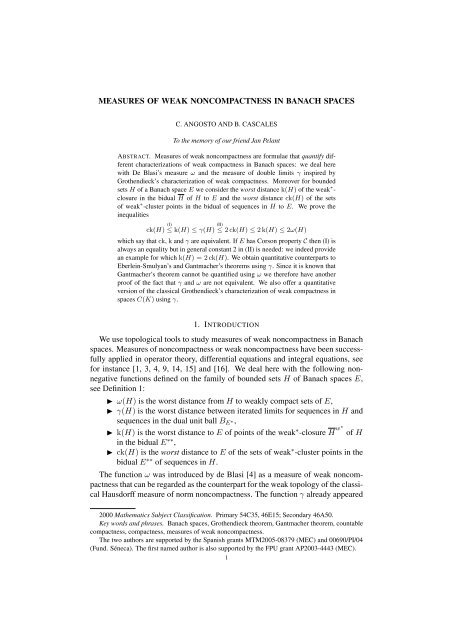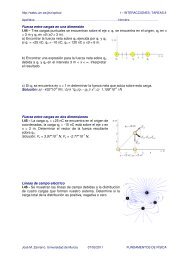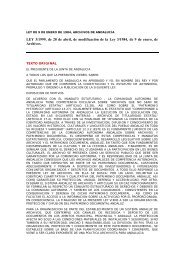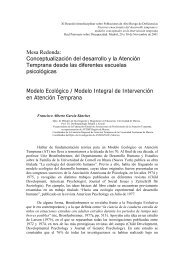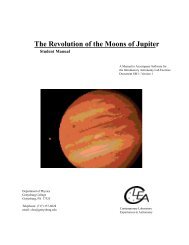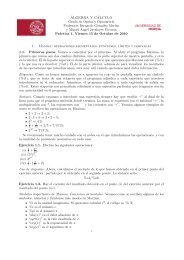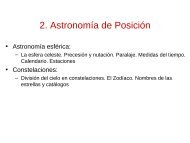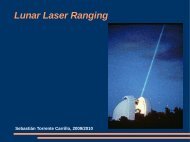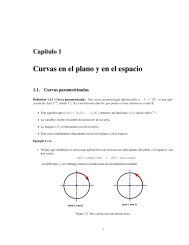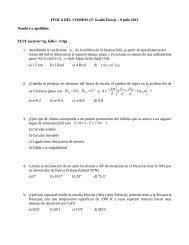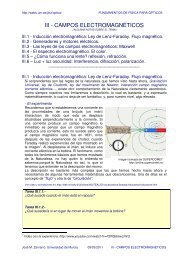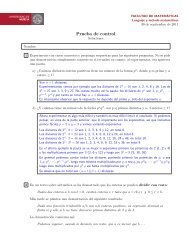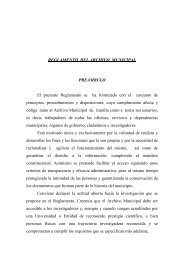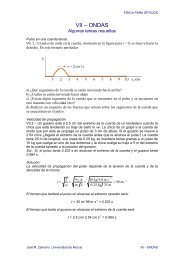MEASURES OF WEAK NONCOMPACTNESS IN BANACH SPACES ...
MEASURES OF WEAK NONCOMPACTNESS IN BANACH SPACES ...
MEASURES OF WEAK NONCOMPACTNESS IN BANACH SPACES ...
You also want an ePaper? Increase the reach of your titles
YUMPU automatically turns print PDFs into web optimized ePapers that Google loves.
<strong>MEASURES</strong> <strong>OF</strong> <strong>WEAK</strong> <strong>NONCOMPACTNESS</strong> <strong>IN</strong> <strong>BANACH</strong> <strong>SPACES</strong><br />
C. ANGOSTO AND B. CASCALES<br />
To the memory of our friend Jan Pelant<br />
ABSTRACT. Measures of weak noncompactness are formulae that quantify different<br />
characterizations of weak compactness in Banach spaces: we deal here<br />
with De Blasi’s measure ω and the measure of double limits γ inspired by<br />
Grothendieck’s characterization of weak compactness. Moreover for bounded<br />
sets H of a Banach space E we consider the worst distance k(H) of the weak ∗ -<br />
closure in the bidual H of H to E and the worst distance ck(H) of the sets<br />
of weak ∗ -cluster points in the bidual of sequences in H to E. We prove the<br />
inequalities<br />
ck(H) (I)<br />
≤ k(H) ≤ γ(H) (II)<br />
≤ 2 ck(H) ≤ 2 k(H) ≤ 2ω(H)<br />
which say that ck, k and γ are equivalent. If E has Corson property C then (I) is<br />
always an equality but in general constant 2 in (II) is needed: we indeed provide<br />
an example for which k(H) = 2 ck(H). We obtain quantitative counterparts to<br />
Eberlein-Smulyan’s and Gantmacher’s theorems using γ. Since it is known that<br />
Gantmacher’s theorem cannot be quantified using ω we therefore have another<br />
proof of the fact that γ and ω are not equivalent. We also offer a quantitative<br />
version of the classical Grothendieck’s characterization of weak compactness in<br />
spaces C(K) using γ.<br />
1. <strong>IN</strong>TRODUCTION<br />
We use topological tools to study measures of weak noncompactness in Banach<br />
spaces. Measures of noncompactness or weak noncompactness have been successfully<br />
applied in operator theory, differential equations and integral equations, see<br />
for instance [1, 3, 4, 9, 14, 15] and [16]. We deal here with the following nonnegative<br />
functions defined on the family of bounded sets H of Banach spaces E,<br />
see Definition 1:<br />
◮ ω(H) is the worst distance from H to weakly compact sets of E,<br />
◮ γ(H) is the worst distance between iterated limits for sequences in H and<br />
sequences in the dual unit ball B E ∗,<br />
◮ k(H) is the worst distance to E of points of the weak ∗ -closure H w∗ of H<br />
in the bidual E ∗∗ ,<br />
◮ ck(H) is the worst distance to E of the sets of weak ∗ -cluster points in the<br />
bidual E ∗∗ of sequences in H.<br />
The function ω was introduced by de Blasi [4] as a measure of weak noncompactness<br />
that can be regarded as the counterpart for the weak topology of the classical<br />
Hausdorff measure of norm noncompactness. The function γ already appeared<br />
2000 Mathematics Subject Classification. Primary 54C35, 46E15; Secondary 46A50.<br />
Key words and phrases. Banach spaces, Grothendieck theorem, Gantmacher theorem, countable<br />
compactness, compactness, measures of weak noncompactness.<br />
The two authors are supported by the Spanish grants MTM2005-08379 (MEC) and 00690/PI/04<br />
(Fund. Séneca). The first named author is also supported by the FPU grant AP2003-4443 (MEC).<br />
1
2 C. ANGOSTO AND B. CASCALES<br />
in [1] and in [15, Theorem 2.2]: in the latter the sup is taken over all the sequences<br />
in the convex hull conv H instead of sequences only in H: very recently<br />
γ has been implicitly used in [5] and [8] where it has been proved, amongst other<br />
things, that γ(H) = γ(conv(H)) which says that our definition for γ is equivalent<br />
to the one given in [15]. k has been used in [5, 8, 11]. Whereas ω and<br />
γ are measures of weak noncompactness in the sense of the axiomatic definition<br />
given in [2] the function k fails to satisfy k(conv H) = k(H), see [12], that is<br />
one of the properties required in order to be a measure of weak noncompactness.<br />
Nonetheless, k as well as γ and ω does satisfy the condition<br />
k(H) = 0 if, and only if, H is relatively weakly<br />
compact in E. This fact for k is illustrated in the adjacent<br />
figure. Notice that for the bounded subset H of<br />
H w∗<br />
E the weak ∗ -closure H w∗<br />
in E ∗∗ is weak ∗ -compact<br />
H H c<br />
and therefore k(H) F igure =: 1 ˆd = 0 is equivalent to<br />
✛ ✲<br />
ˆρ have H w∗<br />
⊂ E and thus equivalent to say that H is<br />
E<br />
relatively weakly compact in E.<br />
E ∗∗<br />
Figure 1<br />
✛ ✲<br />
ˆd<br />
The paper is organized as follows.<br />
In section 2, see Theorem 2.3, we prove that for<br />
any bounded subset in a Banach space E we have the<br />
inequalities<br />
ck(H) ≤ k(H) ≤ γ(H) ≤ 2 ck(H) ≤ 2 k(H) ≤ 2ω(H).<br />
By doing so we establish that ck, k and γ are equivalent; we provide a quantitative<br />
version of the angelicity of a Banach space for the weak topology. We study when<br />
ck = k and we prove that this is the case for the class of Banach spaces with Corson<br />
property C, Proposition 2.6. We also give an example for which k(H) = 2 ck(H),<br />
Example 2.5. Our results here can be viewed as a quantitative counterpart of the<br />
classical Eberlein-Smulyan’s theorem about weak compactness in Banach spaces.<br />
Section 3 is started with Lemma 3 that links the ε-interchanging of limits with<br />
a compact space and the ε-interchanging of limits with some dense subset of it.<br />
This is a common tool that is used to prove quantitative counterparts for γ of Gantmacher<br />
theorem about weak compactness of adjoint operators in Banach spaces,<br />
Theorem 3.1, and for the classical Grothendieck’s characterization of weak compactness<br />
in spaces C(K), Theorem 3.5. We complete this section commenting<br />
on the fact that for the De Blassi measure of weak noncompactness ω, Astala and<br />
Tylli proved in [1] that it is not possible to obtain a quantitative version of Gantmacher<br />
theorem similar to the one in Theorem 3.1: this provides another way of<br />
proving the fact commented in [1] that ω is not equivalent to the measure γ, see<br />
Corollary 3.4.<br />
A bit of terminology: by letters T, X, . . . we denote here sets or completely regular<br />
topological spaces, (Z, d) is a metric space. The space Z X is equipped with<br />
the product topology τ p . In Z X we also consider the standard supremum metric,<br />
that abusively is also denoted by d, i.e.,<br />
d(f, g) = sup{d(f(x), g(x)) : x ∈ X}<br />
for functions f, g : X → Z. C(X) is the space of continuous maps from X into<br />
the real line R.
<strong>MEASURES</strong> <strong>OF</strong> <strong>WEAK</strong> <strong>NONCOMPACTNESS</strong> <strong>IN</strong> <strong>BANACH</strong> <strong>SPACES</strong> 3<br />
For A and B nonempty subsets of a metric space (Z, d), we consider the usual<br />
distance between A and B given by<br />
d(A, B) = inf{d(a, b) : a ∈ A, b ∈ B},<br />
and the Hausdorff non-symmetrized distance from A to B defined by<br />
ˆd(A, B) = sup{d(a, B) : a ∈ A}.<br />
In this paper (E, ‖·‖) is a Banach space (E if ‖·‖ is tacitly assumed). B E stands<br />
for the closed unit ball in E, E ∗ for the dual space and E ∗∗ for the bidual space;<br />
w is the weak topology of a Banach space and w ∗ is the weak ∗ topology in a dual.<br />
We write i : E → E ∗∗ to denote the natural embedding of E into its bidual E ∗∗<br />
and, as usual, most of the times we will not make any distinction between a given<br />
set H ⊂ E and its image H = i(H) ⊂ E ∗∗ . In E ∗∗ we always consider the natural<br />
norm and its associated metric.<br />
2. <strong>MEASURES</strong> <strong>OF</strong> <strong>WEAK</strong> <strong>NONCOMPACTNESS</strong> <strong>IN</strong> <strong>BANACH</strong> <strong>SPACES</strong><br />
Let H be a bounded subset of the Banach space E. If ϕ ∈ H N is a sequence in<br />
H we write<br />
clust E ∗∗(ϕ) := ⋂ {ϕ(m) : m > n} w∗<br />
n∈N<br />
to denote the set of cluster points of ϕ in (E ∗∗ , w ∗ ). We also write H w∗ to denote<br />
the w ∗ -closure of H in E ∗∗ .<br />
Definition 1. Given a bounded subset H of a Banach space E we define:<br />
ω(H) := inf{ε > 0 : H ⊂ K ε + εB E and K ε ⊂ X is w-compact},<br />
γ(H) := sup{| lim<br />
n<br />
lim<br />
m<br />
f m (x n ) − lim<br />
m<br />
lim<br />
n<br />
f m (x n )| : (f m ) ⊂ B E ∗, (x n ) ⊂ H},<br />
assuming the involved limits exist,<br />
ck(H) := sup<br />
ϕ∈H N d(clust E ∗∗(ϕ), E)<br />
and<br />
k(H) := ˆd(H w∗ , E) = sup d(x ∗∗ , E),<br />
x ∗∗ ∈H w∗<br />
where the distance d is the usual inf distance for sets associated to the natural<br />
norm in E ∗∗ .<br />
Observe that for a bounded set H ⊂ E we have<br />
k(H) := inf{ε > 0 : H w∗ ⊂ E + εB E ∗∗}. (2.1)<br />
The notion below introduced in [5] was first considered by Grothendieck in [13],<br />
for ε = 0. For ε ≥ 0, this concept has also been used, in the framework of Banach<br />
spaces, in [1, 8, 15] amongst others.<br />
Definition 2. Let (Z, d) be a metric space, X a set and ε ≥ 0.<br />
(i) We say that a sequence (f m ) m in Z X ε-interchanges limits with a sequence<br />
(x n ) n in X if<br />
d(lim<br />
n<br />
lim<br />
m<br />
f m (x n ), lim<br />
m<br />
lim<br />
n<br />
f m (x n )) ≤ ε<br />
whenever all limits involved do exist.
4 C. ANGOSTO AND B. CASCALES<br />
(ii) We say that a subset H of Z X ε-interchanges limits with a subset A of X, if<br />
each sequence in H ε-interchanges limits with each sequence in A. When<br />
ε = 0 we simply say that H interchanges limits with A.<br />
Observe that if H is a subset of a Banach space E, then γ(H) ≤ ε if, and only<br />
if Hε-interchanges limits with the dual ball B E ∗.<br />
Our starting point for the results in this section are Propositions 2.1 and 2.2 that<br />
we quote below and Lemma 1 that we prove.<br />
Proposition 2.1 ([5, Corollary 2.6] and [8, Proposition 8]). Let E be a Banach<br />
space and let H be a bounded subset of E. The following properties hold:<br />
(i) if H ε-interchanges limits with B X ∗, then k(H) ≤ ε,<br />
(ii) if k(H) ≤ ε, then H 2ε-interchanges limits with B X ∗.<br />
Proposition 2.2 ([5, Proposition 5.2]). Let (Z, d) be a compact metric space, K<br />
a set, and H ⊂ Z K a set which ε-interchanges limits with K. Then for any<br />
f ∈ H ZK , there is a sequence (f n ) n in H such that<br />
for any cluster point g of (f n ) in Z K .<br />
sup d(g(x), f(x)) ≤ ε<br />
x∈K<br />
Lemma 1. Let E be a Banach space and let H be a bounded subset of E. Then H<br />
2 ck(H)-interchanges limits with the dual ball B E ∗.<br />
Proof. Let (f m ) m be a sequence in B E ∗, (x n ) n a sequence in H and let us assume<br />
that both iterated limits<br />
lim<br />
n<br />
lim<br />
m<br />
f m (x n ), lim<br />
m<br />
lim<br />
n<br />
f m (x n )<br />
exist in R. If we fix α ∈ R with α > ck(H) the sequence (x n ) n has a w ∗ -cluster<br />
point z ∈ E ∗∗ such that d(z, E)) < α. Take and fix now z ′ ∈ E such that<br />
‖z − z ′ ‖ < α. (2.2)<br />
Let us pick f ∈ B E ∗ a w ∗ -cluster point of (f m ) m . Since z ′ and each x n belongs<br />
to E, f(z ′ ) and f(x n ) are, respectively, cluster points in R of f m (z ′ ) and f m (x n ).<br />
Hence we can produce a subsequence (f mk ) k of (f m ) m such that lim k f mk (z ′ ) =<br />
f(z ′ ). Thus we have that<br />
We conclude that<br />
| lim<br />
k<br />
f mk (z) − f(z)| ≤<br />
≤ | lim<br />
k<br />
f mk (z) − lim<br />
k<br />
f mk (z ′ )| + |f(z ′ ) − f(z)| (2.2)<br />
≤ 2α.<br />
lim<br />
n<br />
lim<br />
m<br />
f m (x n ) = lim<br />
n<br />
f(x n ) = f(z)<br />
and so<br />
| lim<br />
m<br />
lim<br />
n<br />
f m (x n ) − lim<br />
n<br />
lim<br />
m<br />
f m (x n )| =<br />
= | lim<br />
m<br />
lim<br />
n<br />
f m (x n ) − f(z)| = | lim<br />
k<br />
f mk (z) − f(z)| (2.3)<br />
≤ 2α.<br />
(2.3)<br />
Since α > ck(H) was arbitrary we obtain that H 2 ck(H)-interchanges limits with<br />
B E ∗.<br />
□
<strong>MEASURES</strong> <strong>OF</strong> <strong>WEAK</strong> <strong>NONCOMPACTNESS</strong> <strong>IN</strong> <strong>BANACH</strong> <strong>SPACES</strong> 5<br />
The above preparations lead naturally to the following result.<br />
Theorem 2.3. For any bounded subset H of a Banach space E we have:<br />
ck(H) ≤ k(H) ≤ γ(H) ≤ 2 ck(H) ≤ 2 k(H) ≤ 2ω(H), (2.4)<br />
γ(H) = γ(conv(H)) and ω(H) = ω(conv(H)).<br />
For any x ∗∗ ∈ H w∗ , there is a sequence (x n ) n in H such that<br />
‖x ∗∗ − y ∗∗ ‖ ≤ γ(H) (2.5)<br />
for any cluster point y ∗∗ of (x n ) n in E ∗∗ .<br />
Furthermore, H is weakly relatively compact in E if, and only if, one (equivalently<br />
all) of the numbers ck(H), k(H), γ(H) and ω(H) is zero.<br />
Proof. The inequality ck(H) ≤ k(H) straightforwardly follows from the definitions<br />
involved. The inequality k(H) ≤ γ(H) is a consequence of statement (i) in<br />
Proposition 2.1. The inequality γ(H) ≤ 2 ck(H) follows from Lemma 1.<br />
The approximation (2.5) straightforwardly follows from Proposition 2.2 after<br />
the convenient identification of (H w∗ , w ∗ ) as a subspace of ([−M, M] B E ∗ , τ p )<br />
where M is a bound for H.<br />
On the other hand γ(H) = γ(conv(H)) has been established in [8, Theorem 13]<br />
and [5, Theorem 3.3]. The equality ω(H) = ω(conv(H)) follows from the very<br />
definition of ω using that the validity of Krein-Smulyan theorem stating that the<br />
closed convex hull of weakly compact sets in Banach spaces are weakly compact.<br />
A well known result of Grothendieck, [7, Lemma 2, p. 227] states that ω(H) =<br />
0 if, and only if, H is relatively weakly compact in E. Observe that as a consequence<br />
of (2.4) one of the numbers ck(H), k(H) γ(H) is zero if, and only if, all<br />
of them are zero. Clearly, k(H) = 0 if, and only if, H w∗ ⊂ E that is equivalent to<br />
the fact that H is relatively weakly compact.<br />
To finish we prove the very last inequality in (2.4). Take ε > 0 and a weakly<br />
compact set K ε ⊂ E such that H ⊂ K ε + εB E . We have that<br />
H w∗ ⊂ K ε + εB E ∗∗ ⊂ E + εB E ∗∗.<br />
If we use (2.1) we obtain k(H) ≤ ω(H) and the proof is over.<br />
□<br />
We refer the interested reader to [15] where measures of weak noncompactness<br />
are defined: all of the conditions there are fulfilled by γ and ω and most of them<br />
by ck and k. As a consequence of the above ck, k, γ are equivalent while ω is not<br />
equivalent to the other ones, see Corollary 3.4.<br />
A topological space T is said to be angelic if, whenever H is a relatively countably<br />
compact subset of T , its closure H is compact and each element of H is a<br />
limit of a sequence in H. Our references for angelic spaces are [10] and [17].<br />
Theorem 2.3 above is the quantitative version of the angelicity of a Banach space<br />
endowed with its weak topology, Eberlein-Smulyan’s theorem.<br />
Corollary 2.4. If E is a Banach space then (E, w) is angelic.<br />
Proof. Let H be a w-relatively countably compact subset of E. By the very definition<br />
every sequence in H has a w-cluster point in E and therefore ck(H) = 0.<br />
Then by Theorem 2.3 we have H is w-relatively compact in E. On the other hand,<br />
let us pick x ∈ H w . Note that inequality (2.4) implies that γ(H) = 0 and thus<br />
if we use (2.5) we obtain the existence of a sequence (x n ) n in H such that every
6 C. ANGOSTO AND B. CASCALES<br />
w-cluster point y ∈ E of (x n ) n satisfies that 0 ≤ ‖y − x‖ ≤ γ(H) = 0. Since<br />
H is w-relatively compact and (x n ) n in H and x is the unique w-cluster point of<br />
(x n ) n we conclude that (x n ) n weakly converges to x and the proof is over. □<br />
Talking about ck and k, it is pretty easy to prove that if E ∗ is separable for the<br />
norm, then for every bounded set H ⊂ E we have ck(H) = k(H). Keeping this<br />
in mind it is easy to produce an example showing that constant 2 for the inequality<br />
γ(H) ≤ 2 ck(H) it is truly needed: indeed, take E = c the space of convergent<br />
real sequences and H := B c its unit ball. On the one hand ck(B c ) = k(B c ) is<br />
equal to 1 after Riesz lemma and on the other hand considering elements of the<br />
type (1, . . . , 1, −1, . . . , −1, . . . ) and the n-th projections π n : c → R one easily<br />
computes that γ(B c ) = 2, see [15, p. 93].<br />
Now we give a more involved example showing that even for the inequality<br />
k(H) ≤ 2 ck(H) the constant 2 is needed.<br />
Example 2.5. The following example has been communicated to us by Prof. Marciszewski.<br />
Consider [0, ω 1 ] the compact set of all the ordinals smaller or equal to<br />
the first non countable ordinal ω 1 . Put<br />
K = ({−1, 1} × [0, ω 1 ])/R<br />
where R is the relation defined as xRy if, and only if<br />
x = y or x, y ∈ {(−1, ω 1 ), (1, ω 1 )}.<br />
Clearly K is a compact set. For α ≺ ω 1 define f α : K → R as<br />
{ 0 if γ ≻ α,<br />
f α (i, γ) =<br />
i if γ ≼ α<br />
and put H = {f α : α ≺ ω 1 } ⊂ C(K). Since H is uniformly bounded and K<br />
is scattered, the w ∗ -topology in H w∗<br />
⊂ C(K) ∗∗ = l ∞ (K) coincides with the<br />
product topology of R K . If (f αn ) n is a sequence in H and α := sup{α n : n ∈ N}<br />
then α ≺ ω 1 and f αn (i, β) = 0 for all n ∈ N and β ≻ α. So for every β ≻ α we<br />
have that g(i, β) = 0 for each cluster point g of (f αn ) n . If we define h : K → R<br />
as h(i, β) = 0 if β ≻ α and h(i, β) = i/2 if β ≼ α then h ∈ C(K) and d(h, g) ≤<br />
1/2 for each cluster point g of (f αn ) n . Thus we conclude that ck(H) ≤ 1/2. On<br />
the other hand, the function h ′ : K → R defined as h ′ (i, β) = 0 if β = ω 1 and<br />
h ′ (i, β) = i if β ≠ ω 1 belongs to H RK and clearly d(h ′ , C(K)) = 1. Then<br />
k(H) = ˆd(H w∗ , C(K)) ≥ d(h ′ , C(K)) ≥ 1 ≥ 2 ck(H)<br />
and therefore by Theorem 2.3 d(H w∗ , C(K)) = 2 ck(H).<br />
□<br />
We will devote the rest of the section to prove that the equality ck = k holds<br />
for a pretty wide class of Banach spaces E enjoying Corson property C. To do<br />
so we isolate first the following easy lemma that is inspired by the proof of [8,<br />
Proposition 14].<br />
Lemma 2. If x ∗∗ ∈ E ∗∗ \ E and b ∈ R satisfies d(x ∗∗ , E) > b > 0, then<br />
0 ∈ {x ∗ ∈ B E ∗ : x ∗∗ (x ∗ ) > b} w∗ .
<strong>MEASURES</strong> <strong>OF</strong> <strong>WEAK</strong> <strong>NONCOMPACTNESS</strong> <strong>IN</strong> <strong>BANACH</strong> <strong>SPACES</strong> 7<br />
Proof. We simply prove that for each ε > 0 and finitely many x 1 , x 2 , . . . , x n ∈ E<br />
the w ∗ -neighborhood of the origin in E ∗<br />
V (0, x 1 , x 2 , . . . , x n , ε) := {y ∗ ∈ E ∗ : sup |y ∗ (x i )| < ε}<br />
1≤i≤n<br />
intersects the set S(x ∗∗ , b) := {x ∗ ∈ B E ∗ : x ∗∗ (x ∗ ) > b}. Hahn-Banach’s theorem<br />
provides us with a functional φ ∈ E ∗∗∗ such that φ(x) = 0 for every x ∈ E,<br />
‖φ‖ = 1 and φ(x ∗∗ ) = d(x ∗∗ , E), [6, Corollary 6.8]. We can and do assume that<br />
b < b + ε < d(x ∗∗ , X). We use Goldstine’s theorem for B E ∗ ⊂ B E ∗∗∗ to find an<br />
element x ∗ in B E ∗ such that<br />
|φ(x i ) − x ∗ (x i )| = |x ∗ (x i )| < ε, i = 1, 2, . . . , n, (2.6)<br />
and<br />
|φ(x ∗∗ ) − x ∗∗ (x ∗ )| < ε. (2.7)<br />
The inequalities (2.6) imply that x ∗ , −x ∗ ∈ V (0, x 1 , x 2 , . . . , x n , ε). On the other<br />
hand inequality (2.7) implies that<br />
|x ∗∗ (x ∗ )| = |(x ∗∗ (x ∗ )−φ(x ∗∗ )) + φ(x ∗∗ )| ≥ ∣ ∣|x ∗∗ (x ∗ ) − φ(x ∗∗ )| − |φ(x ∗∗ )| ∣ All things considered, either x ∗ or −x ∗ belongs to<br />
and the proof is over.<br />
= |φ(x ∗∗ )| − |x ∗∗ (x ∗ ) − φ(x ∗∗ )| > b + ε − ε = b.<br />
V (0, x 1 , x 2 , . . . , x n , ε) ∩ S(x ∗∗ , b)<br />
Recall that a Banach space E is said to have Corson property C if each collection<br />
of closed convex subsets of E with empty intersection has a countable subcollection<br />
with empty intersection. If (E, w) is Lindelöf, then E has property C. There<br />
are Banach spaces with Corson property C which are not weakly Lindelöf, [18, p.<br />
146]. It is shown in [18] that the Banach space E has the property C if and only<br />
if, whenever A ⊂ E ∗ and x ∗ ∈ A w∗ , there is a countable subset C of A such that<br />
x ∗ ∈ conv C w∗ . In particular Banach spaces with w ∗ angelic dual unit balls have<br />
Corson property C.<br />
Proposition 2.6. If E is a Banach space with Corson property C, then for every<br />
bounded set H ⊂ E we have ck(H) = k(H).<br />
Proof. We already know that ck(H) ≤ k(H), Theorem 2.3. Therefore if k(H) = 0<br />
the equality holds. Otherwise, we prove that for every 0 < b < k(H) we have b ≤<br />
ck(H) that clearly implies ck(H) = k(H). For such a b we take x ∗∗ ∈ H w∗ \E<br />
with d(x ∗∗ , E) > b. Lemma 2 tells us that if we write<br />
S(x ∗∗ , b) := {x ∗ ∈ B E ∗ : x ∗∗ (x ∗ ) > b}<br />
then 0 ∈ S(x ∗∗ , b) w∗ . Now, property C of E applies to provide us with a countable<br />
subset C of S(x ∗∗ , b) such that 0 ∈ conv C w∗ . Since S(x ∗∗ , b) is convex, there<br />
is a countable set D of S(x ∗∗ , b) such that 0 ∈ D w∗ . Since D is countable, H w∗<br />
is pseudo-metrizable in the topology of pointwise convergence on D. So one can<br />
choose a sequence (h n ) n in H that converges to x ∗∗ pointwise on D. Therefore, if<br />
h ∗∗ is any w ∗ -cluster point of (h n ) n , then h ∗∗ | D = x ∗∗ | D . In particular, we have<br />
that<br />
h ∗∗ (x ∗ ) = x ∗∗ (x ∗ ) > b,<br />
□
8 C. ANGOSTO AND B. CASCALES<br />
for each x ∗ ∈ D. On the other hand, since 0 ∈ D w∗ , for fixed arbitrary h ∈ E and<br />
ε > 0 there is some x ∗ ∈ D such that |x ∗ (h)| < ε. Consequently<br />
‖h ∗∗ − h‖ ≥ h ∗∗ (x ∗ ) − x ∗ (h) > b − ε.<br />
Since ε and h are arbitrary we conclude that d(h ∗∗ , E) ≥ b for every w ∗ -cluster<br />
point h ∗∗ of ϕ = (h n ) n . We conclude that<br />
and the proof is over.<br />
ck(H) ≥ d(clust E ∗∗(ϕ), E) ≥ b<br />
A different proof of Proposition 2.6 can be given for the particular case of Banach<br />
spaces E with angelic dual unit ball (B E ∗, w ∗ ) that we sketch briefly: in this<br />
case we argue by contradiction. We assume that there is a bounded set H ⊂ E such<br />
that ck(H) < b < k(H). Then we proceed as we did in the proof of Proposition 2.6<br />
taking x ∗∗ ∈ H w∗ \E with d(x ∗∗ , E) > b and 0 ∈ S(x ∗∗ , b) w∗ . The angelicity of<br />
(B E ∗, w ∗ ) provides us with a sequence (x ∗ n) n in S(x ∗∗ , b) with w ∗ − lim n x ∗ n = 0.<br />
If we define now the linear operator<br />
T : E −→ c 0<br />
x (x ∗ n(x)) n<br />
then ‖T ‖ ≤ 1 and one readily computes that ck(T (H)) ≤ ck(H). Following up<br />
the proof of Theorem 3 in [11] one concludes that d(T ∗∗ (x ∗∗ ), c 0 )≥b that leads to<br />
k(T (H))≥d(T ∗∗ (x ∗∗ ), c 0 )≥b>ck(H)≥ck(T (H)),<br />
that contradicts that ck = k in c 0 because c ∗ 0 = l 1 is separable.<br />
We gratefully acknowledge the comments of Professor V. Kadets that upon the<br />
reading of a preliminary version of this paper, where Proposition 2.6 was proved<br />
for Banach spaces with angelic dual unit ball, came up with some of the ideas we<br />
have presented now that works for the more general Banach spaces with Corson<br />
property C.<br />
Observe that ck(H) = k(H) implies that ˆd(H w∗ , E) = ˆd(H c , E) where<br />
H c :=<br />
⋃<br />
clust E ∗∗(ϕ),<br />
ϕ∈H N<br />
although it might happen that H c H w∗ . Indeed, if Γ is a non countable set then<br />
c 0 (Γ) is weakly compactly generated, hence weakly Lindelöf and in particular it<br />
has Corson property C. Therefore ck = k in c 0 (Γ). On the other hand, the unit ball<br />
H := B c0 (Γ) and H c are made up of functions defined of Γ with countable support<br />
and consequently B l ∞ (Γ) = H w∗ contains properly H c : we have tried to illustrate<br />
H c in the Figure 1 and where have written ˆρ = ˆd(H c , E).<br />
3. QUANTITATIVE VERSIONS <strong>OF</strong> GANTMACHER AND GROTHENDIECK<br />
THEOREMS<br />
The Hausdorff measure of norm noncompactness is defined for bounded sets H<br />
of Banach spaces E as<br />
h(H) := inf{ε > 0 : H ⊂ K ε + εB E and K ε ⊂ X is finite}.<br />
A theorem of Schauder states that a continuous linear operator T : E → F is compact<br />
if, and only if, its adjoint operator T ∗ : F ∗ → E ∗ is compact. A quantitative<br />
□
<strong>MEASURES</strong> <strong>OF</strong> <strong>WEAK</strong> <strong>NONCOMPACTNESS</strong> <strong>IN</strong> <strong>BANACH</strong> <strong>SPACES</strong> 9<br />
strengthening of Schauder’s result was proved by Goldenstein and Marcus (cf. [1,<br />
p. 367]) who established the inequalities<br />
1<br />
2 h(T (B E)) ≤ h(T ∗ (B F ∗)) ≤ 2 h(T (B E )). (3.1)<br />
For weak topologies Gantmacher established that the operator T is weakly compact<br />
if, and only if, T ∗ is weakly compact. Nonetheless, the corresponding quantitative<br />
version to (3.1) where h is replaced by ω fails for general Banach spaces, see<br />
Remark 3.3. On the positive side we prove in Theorem 3.1 a quantitative version<br />
of Gantmacher result for γ. In order to do this we need first the lemma below that<br />
can be obtained combining Propositions 2.2 and 2.4 in [5]: we prefer to include a<br />
selfcontained straightforward proof for the lemma though.<br />
Lemma 3. Let K be a compact topological space, D a dense subset of K, H a<br />
uniformly bounded subset of C(K) and ε > 0. If H ε-interchanges limits with D,<br />
then H 2ε-interchanges limits with K.<br />
Proof. Fix δ > ε. We first prove the claim below:<br />
CLAIM: If f ∈ H RK , then for every y ∈ K there exist a neighborhood V of y in<br />
K such that<br />
sup |f(d) − f(y)| ≤ δ. (3.2)<br />
d∈V ∩D<br />
We prove the claim by contradiction: we assume that sup d∈U∩D |f(d)−f(y)| > δ<br />
for each neighborhood U of y and we will contradict that H ε-interchanges limits<br />
with D. Indeed, let us write d 0 = y. Since f ∈ H RK , there exist g 1 ∈ H such that<br />
|f(d 0 ) − g 1 (d 0 )| ≤ 1. Since g 1 is continuous there exist a neighborhood U of y<br />
such that |g 1 (d 0 ) − g 1 (d)| ≤ 1 for all d in U. By assumption, there is d 1 ∈ U ∩ D<br />
such that |f(d 1 ) − f(d 0 )| > δ. Proceeding by recurrence we produce sequences<br />
(d n ) n in D and (g n ) n in H such that for every n ∈ N we have<br />
|g n (d i ) − f(d i )| ≤ 1 n<br />
i = 0, 1, . . . , n − 1 (3.3)<br />
|g j (d n ) − g j (d 0 )| ≤ 1 n<br />
j = 1, . . . , n (3.4)<br />
|f(d n ) − f(d 0 )| > δ. (3.5)<br />
Choosing a subsequence we can assume that (f(d n )) n converges in R. Then we<br />
have<br />
lim lim g m (d n ) (3.3)<br />
= lim f(d n ),<br />
n m n<br />
so<br />
lim<br />
m<br />
lim<br />
n<br />
g m (d n ) (3.4)<br />
= lim<br />
m<br />
g m (d 0 ) (3.3)<br />
= f(d 0 ) = f(y),<br />
| lim<br />
n<br />
lim<br />
m<br />
g m (d n ) − lim<br />
m<br />
lim<br />
n<br />
g m (d n )| = | lim<br />
n<br />
f(d n ) − f(y)| (3.5)<br />
≥ δ,<br />
that contradicts that H ε-interchanges limits with D and finishes the proof of the<br />
claim.<br />
We finish now the proof of the lemma. Take sequences (x n ) n in K and (f m ) m<br />
in H for which the double limits lim n lim m f m (x n ) and lim m lim n f m (x n ) exist.
10 C. ANGOSTO AND B. CASCALES<br />
If we take f ∈ H RK and x ∈ K, cluster points of (f m ) m in R K and (x n ) n in K,<br />
respectively, then we have<br />
and<br />
lim<br />
m<br />
lim<br />
n<br />
Consequently we obtain that<br />
f m (x n ) = lim<br />
m<br />
f m (x) = f(x)<br />
lim<br />
n<br />
lim<br />
m<br />
f m (x n ) = lim<br />
n<br />
f(x n ).<br />
| lim<br />
n<br />
lim<br />
m<br />
f m (x n ) − lim<br />
m<br />
lim<br />
n<br />
f m (x n )| = | lim<br />
n<br />
f(x n ) − f(x)| = L.<br />
By the claim there is a neighborhood U of x such that sup d∈U∩D |f(x)−f(d)| ≤ δ.<br />
For every n in N, there exist k > n such that x k ∈ U. Now the claim applies<br />
again to provide us with a neighborhood V of x k contained in U such that<br />
sup d∈V ∩D |f(x k ) − f(d)| ≤ δ. If we pick d k ∈ V ∩ D, we have that<br />
|f(x k ) − f(x)| ≤ |f(x k ) − f(d k )| + |f(d k ) − f(x)| ≤ 2δ.<br />
Thus L ≤ 2δ and since we can repeat this argument for any arbitrary δ > ε, we<br />
conclude that H 2ε-interchanges limits with K.<br />
□<br />
Theorem 3.1. Let E and F be Banach spaces, T : E → F an operator and<br />
T ∗ : F ∗ → E ∗ its adjoint. Then<br />
γ(T (B E )) ≤ γ(T ∗ (B F ∗)) ≤ 2γ(T (B E )).<br />
Proof. If we take sequences (x n ) n in B E and (y ∗ m) m in B F ∗, the very definition of<br />
T ∗ implies that<br />
lim<br />
n<br />
lim<br />
m<br />
y ∗ m(T (x n )) = lim<br />
n<br />
lim<br />
m<br />
T ∗ (y ∗ m)(x n ),<br />
lim<br />
m<br />
lim<br />
n<br />
y ∗ m(T (x n )) = lim<br />
m<br />
lim<br />
n<br />
T ∗ (y ∗ m)(x n )<br />
(3.6)<br />
whenever the limits in the left hand sides (or the right hand sides) do exist. Hence,<br />
if (x n ) n and (y ∗ m) m are as above assuming that the limits on the left hand side<br />
of (3.6) exist then<br />
| lim<br />
n<br />
lim<br />
m<br />
y ∗ m(T (x n )) − lim<br />
m<br />
lim<br />
n<br />
y ∗ m(T (x n ))| ≤ γ(T ∗ (B F ∗)).<br />
Consequently we obtain that γ(T (B E )) ≤ γ(T ∗ (B F ∗)).<br />
The other way around, if (x n ) n and (y ∗ m) m are as above assuming that the limits<br />
on the right hand side of (3.6) exist then<br />
| lim<br />
n<br />
lim<br />
m<br />
T ∗ (y ∗ m)(x n ) − lim<br />
m<br />
lim<br />
n<br />
T ∗ (y ∗ m)(x n )| ≤ γ(T (B E )).<br />
In other words, we get that T ∗ (B F ∗) ⊂ C(B E ∗∗, w ∗ ) γ(T (B E ))-interchanges<br />
limits with B E ⊂ B E ∗∗. Since B E is w ∗ -dense in B E ∗∗ we can apply Lemma 3 to<br />
obtain γ(T ∗ (B F ∗)) ≤ 2γ(T (B E )).<br />
□<br />
Corollary 3.2 (Gantmacher). Let E and F be Banach spaces, T : E → F an<br />
operator and T ∗ : F ∗ → E ∗ its adjoint. T is weakly compact if, and only if, T ∗ is<br />
weakly compact.<br />
Proof. Theorems 3.1 and 2.3 apply to conclude that γ(T (B E )) = 0 (i.e. T (B E )<br />
is relatively weakly compact) if, and only if, γ(T ∗ (B F ∗)) = 0 (i.e. T ∗ (B F ∗) is<br />
relatively weakly compact).<br />
□
<strong>MEASURES</strong> <strong>OF</strong> <strong>WEAK</strong> <strong>NONCOMPACTNESS</strong> <strong>IN</strong> <strong>BANACH</strong> <strong>SPACES</strong> 11<br />
Remark 3.3. Astala and Tylli constructed in [1, Theorem 4] a separable Banach<br />
space E and a sequence (T n ) n of operators T n : E → c 0 such that<br />
ω(T ∗ n(B l 1)) = 1 and ω(T ∗∗<br />
n (B ∗∗<br />
E )) ≤ w(T n (B E )) ≤ 1 n .<br />
Note that this example says, in particular, that there are no constants m, M > 0<br />
such that for any bounded operator T : E → F we have<br />
mω(T (B E )) ≤ ω(T ∗ (B F ∗)) ≤ Mω(T (B E )).<br />
Corollary 3.4. γ and ω are not equivalent measures of weak noncompactness,<br />
namely there is no N > 0 such that for any Banach space and any bounded set<br />
H ⊂ E we have<br />
ω(H) ≤ Nγ(H). (3.7)<br />
Proof. If we assume that there is N satisfying (3.7), then inequality (2.4) allows us<br />
to complete inequality (3.7) as<br />
1<br />
γ(H) ≤ ω(H) ≤ Nγ(H),<br />
2<br />
for any bounded subset H of any arbitrary Banach space E. Theorem 3.1 applies<br />
to conclude that for any bounded operator between arbitrary Banach spaces T :<br />
E → F we have to have<br />
1<br />
2N ω(T (B E)) ≤ ω(T ∗ (B F ∗)) ≤ 4Nω(T (B E ))<br />
that contradicts the example in Remark 3.3.<br />
□<br />
We have to stress that the fact that γ and ω are not equivalent has been noted in<br />
[1, Corollary 5 and p. 372]: Astala and Tylli proved in their Corollary 5 that there<br />
exist a separable Banach space E, a linear isometry J : E → l ∞ and a sequence<br />
(B n ) n of bounded sets of E with ω(B n ) = 1 and ω(JB n ) ≤ 1 n<br />
for each n ∈ N.<br />
But γ(IB) = γ(B) for all linear isometries I so γ and ω are not equivalent.<br />
To finish, we give another application of the techniques we have developed here:<br />
we prove a quantitative strengthening of Grothendieck’s classical characterization<br />
of weakly compact sets in spaces C(K). If H ⊂ C(K) we define<br />
γ K (H) := sup{| lim<br />
n<br />
lim<br />
m<br />
f m (x n ) − lim<br />
m<br />
lim<br />
n<br />
f m (x n )| : (f m ) ⊂ H, (x n ) ⊂ K}.<br />
Theorem 3.5. Let K be a compact space and let H be a uniformly bounded subset<br />
of C(K). Then we have<br />
γ K (H) ≤ γ(H) ≤ 2γ K (H).<br />
Proof. The inequality γ K (H) ≤ γ(H) is clear. Let us prove the second inequality:<br />
fix M > 0 a uniform bound for H. For every x ∈ K let us write δ x : C(K) → R<br />
to denote the Dirac measure at x and let us define D := {±δ x : x ∈ K}. If we<br />
consider D| H ⊂ [−M, M] H , then D| H γ K (H)-interchanges limits with H, therefore<br />
we can apply [5, Theorem 3.3] to obtain that conv(D)| H γ K (H)-interchanges<br />
limits with H. In other words, H γ K (H)-interchanges with conv(D) ⊂ B C(K) ∗.<br />
Since conv(D) is w ∗ -dense in B C(K) ∗ we can apply Lemma 3 to obtain that H<br />
2γ K (H)-interchanges with B C(K) ∗, i.e., γ(H) ≤ 2γ K (H).<br />
□<br />
Since a bounded subset H of a Banach space is τ p -relatively compact if, and<br />
only if γ K (H) = 0 (see [10, p.12] or [5, Corollary 2.5]), we get the following<br />
corollary.
12 C. ANGOSTO AND B. CASCALES<br />
Corollary 3.6. Let K be a compact space and let H be a uniformly bounded subset<br />
of C(K), then H is τ p -relatively compact if, and only if, H is w-relatively compact.<br />
REFERENCES<br />
[1] K. Astala and H. O. Tylli, Seminorms related to weak compactness and to Tauberian operators,<br />
Math. Proc. Cambridge Philos. Soc. 107 (1990), no. 2, 367–375. MR MR1027789 (91b:47016)<br />
[2] J. Banaś and A. Martinón, Measures of weak noncompactness in Banach sequence spaces,<br />
Portugal. Math. 52 (1995), no. 2, 131–138. MR MR1342976 (96i:46010)<br />
[3] J. M. Ayerbe Toledano T. Domínguez Benavides and G. López, Measures of noncompactness<br />
in metric fixed point theory, Operator Theory: Advances and Applications, vol. 99, Birkhäuser<br />
Verlag, Basel, 1997. MR MR1483889 (99e:47070)<br />
[4] F. S. De Blasi, On a property of the unit sphere in a banach space, Colloq. Math. 65 (1992),<br />
333–343.<br />
[5] B. Cascales, W. Marciszesky, and M. Raja, Distance to spaces of continuous functions, Topology<br />
Appl. 153 (2006), no. 13, 2303–2319. MR MR2238732<br />
[6] J. B. Conway, A course in functional analysis, Graduate Texts in Mathematics, vol. 96,<br />
Springer-Verlag, New York, 1985. MR 86h:46001<br />
[7] J. Diestel, Sequences and series in Banach spaces, Graduate Texts in Mathematics, vol. 92,<br />
Springer-Verlag, New York, 1984. MR 85i:46020<br />
[8] M. Fabian, P. Hájek, V. Montesinos, and V. Zizler, A quantitative version of Krein’s theorem,<br />
Rev. Mat. Iberoamericana 21 (2005), no. 1, 237–248. MR MR2155020 (2006b:46011)<br />
[9] M. Fan, Lions-Schechter’s methods of complex interpolation and some quantitative estimates,<br />
J. Approx. Theory 140 (2006), no. 1, 46–60. MR MR2226676 (2007c:46021)<br />
[10] K. Floret, Weakly compact sets, Lecture Notes in Mathematics, vol. 801, Springer, Berlin, 1980,<br />
Lectures held at S.U.N.Y., Buffalo, in Spring 1978. MR 82b:46001<br />
[11] A. S. Granero, An extension of the Krein-Smulian Theorem, Rev. Mat. Iberoamericana 22<br />
(2005), no. 1, 93–110.<br />
[12] A. S. Granero, P. Hájek, and V. Montesinos Santalucía, Convexity and w ∗ -compactness in Banach<br />
spaces, Math. Ann. 328 (2004), no. 4, 625–631. MR MR2047643 (2005c:46020)<br />
[13] A. Grothendieck, Critères de compacité dans les espaces fonctionnels généraux, Amer. J. Math.<br />
74 (1952), 168–186. MR 13,857e<br />
[14] A. Kryczka, Quantitative approach to weak noncompactness in the polygon interpolation<br />
method, Bull. Austral. Math. Soc. 69 (2004), no. 1, 49–62. MR MR2040049 (2005a:46152)<br />
[15] A. Kryczka and S. Prus, Measure of weak noncompactness under complex interpolation, Studia<br />
Math. 147 (2001), no. 1, 89–102. MR MR1853479 (2002h:46122)<br />
[16] A. Kryczka, S. Prus, and M. Szczepanik, Measure of weak noncompactness and real interpolation<br />
of operators, Bull. Austral. Math. Soc. 62 (2000), no. 3, 389–401. MR MR1799942<br />
(2001i:46116)<br />
[17] J. Orihuela, Pointwise compactness in spaces of continuous functions, J. London Math. Soc. (2)<br />
36 (1987), no. 1, 143–152. MR 88f:46058<br />
[18] R. Pol, On a question of H. H. Corson and some related problems, Fund. Math. 109 (1980),<br />
no. 2, 143–154. MR 82a:46022<br />
DEPARTAMENTO DE MATEMÁTICAS, UNIVERSIDAD DE MURCIA, 30.100 ESP<strong>IN</strong>ARDO<br />
MURCIA, SPA<strong>IN</strong><br />
E-mail address: angosto@um.es<br />
DEPARTAMENTO DE MATEMÁTICAS, UNIVERSIDAD DE MURCIA, 30.100 ESP<strong>IN</strong>ARDO<br />
MURCIA, SPA<strong>IN</strong><br />
E-mail address: beca@um.es


